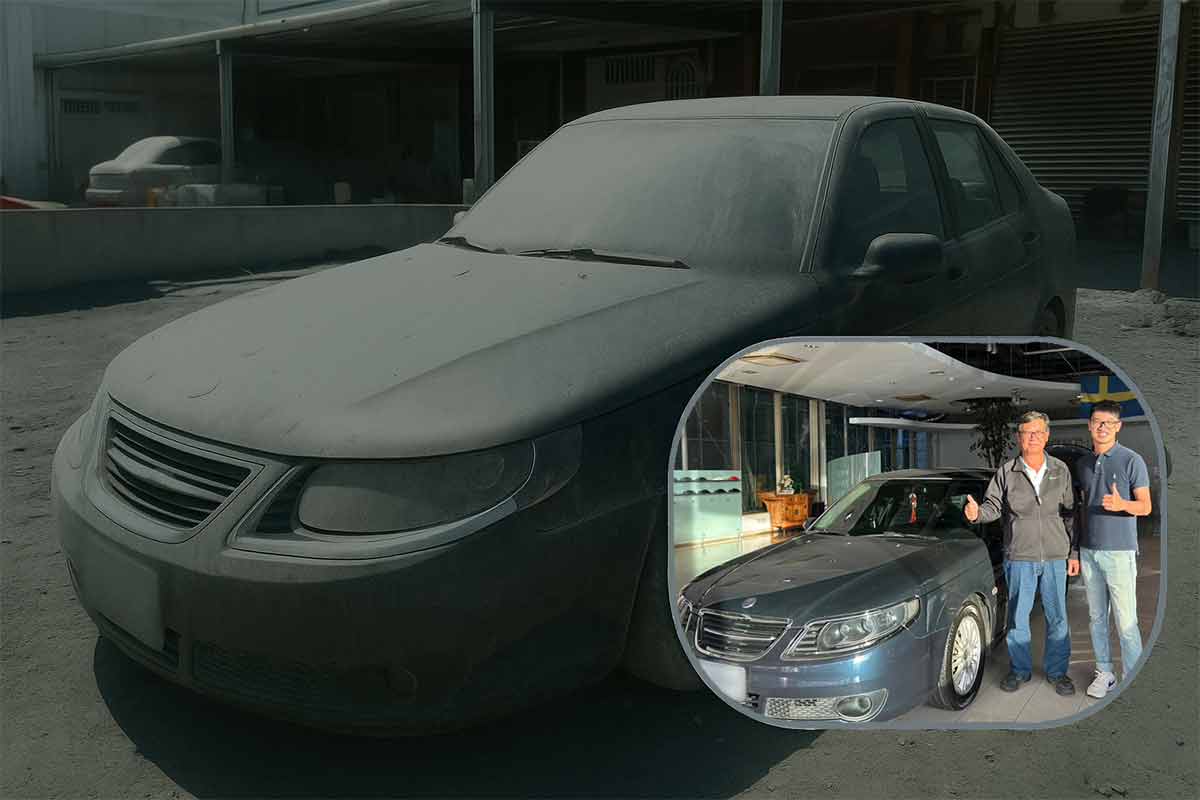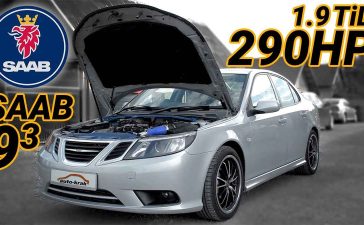A Saab Pulled From the Silence of Disaster
I never expected that the most unforgettable Saab story of my career would begin in complete silence—broken only by the distant rumble of excavators and the heavy smell of wet soil. When Typhoon Ragasa struck eastern Taiwan in late September, the devastation it left behind in Guangfu Township seemed beyond what any mechanic could help repair. Entire neighborhoods disappeared under layers of mud, bridges were torn open, and the lives of thousands were suddenly stripped to their foundations.
Among the hundreds of vehicles swallowed by the torrent was a 2006 Saab 9-5, a car that had spent nearly two decades with its family. When we at SAC Motors first saw the photos, even we hesitated. A dark blue sedan, once cared for with pride, sat frozen under a thick coat of silt – like a fossil pulled from the riverbed. Most would have walked away. But Saab owners are rarely “most people,” and this family refused to let memories sink with the mud.

So they called us. And without a second thought, we packed our tools, loaded a few crates of electrical cleaner and spare components, and prepared for a road trip that would test not only our technical skill but what it means to serve a community shaken by disaster.
The Lake That Should Not Have Burst
Typhoon Ragasa’s rainfall pushed every natural limit in the region. At 2:30 p.m. on September 23, the landslide-dammed lake upstream of Mataian Creek – already swollen to dangerous levels – finally overran its banks. What followed was not a typical flood. It was a wall of water mixed with earth, rock, and uprooted forest, a surge powerful enough to rip apart the Mataian Creek Bridge and hurl entire sections of roadway downstream.
Two massive flood peaks swept through Guangfu Township in the following hours, releasing an estimated 60 million tons of water. When the currents withdrew, half the township looked as if it had been poured from concrete. Satellite photos showed entire blocks buried in mud so deep that only rooflines hinted at what had once stood there.
The official toll – 18 deaths, 6 missing, 125 injured – captured only part of the tragedy. What it did not show were the ruined belongings, the shock on people’s faces as they stood before what used to be their homes, and the heart-stopping realization that recovery would take months or even years.
It also didn’t show the resilience that followed. Within days, Guangfu filled with volunteers – ordinary people from every prefecture, including foreign residents and migrant workers. They shoveled, dredged, restored wiring, and offered supplies. Taiwan Railways counted nearly 400,000 passengers passing through Guangfu Station during the two weeks after the disaster, forty times the township’s population.
In this chaos, a single Saab was waiting, buried and silent, but still holding a family’s past tightly inside its mud-filled cabin.
A Car With More History than Market Value
When we first spoke with Mr. Wu, the Saab’s owner, his voice carried the weight of someone dealing with more than material loss. The car had accompanied him through graduation, engagement, marriage, and the early years of family life. It had been present for joyful drives, long discussions, and numerous weekend escapes across Taiwan’s mountains.
To anyone outside the Saab community, a nearly 20-year-old sedan submerged in a natural disaster would seem like nothing more than an insurance write-off.
But as Mr. Wu said to us, “This car isn’t transportation—it’s part of our family.”
Even without hearing him say it, we would have understood. Saab loyalty tends to be built on stories rather than depreciation curves.
Flood-damaged cars are notoriously difficult to revive. Mud infiltrates connectors, corrodes modules, blocks drain routes, and saturates sound insulation until it behaves like a mold incubator. The longer the vehicle remains buried, the more complicated the restoration becomes.
When Mr. Wu asked us what to do, we gave the only answer that felt right:
“We’ll come to Guangfu.”
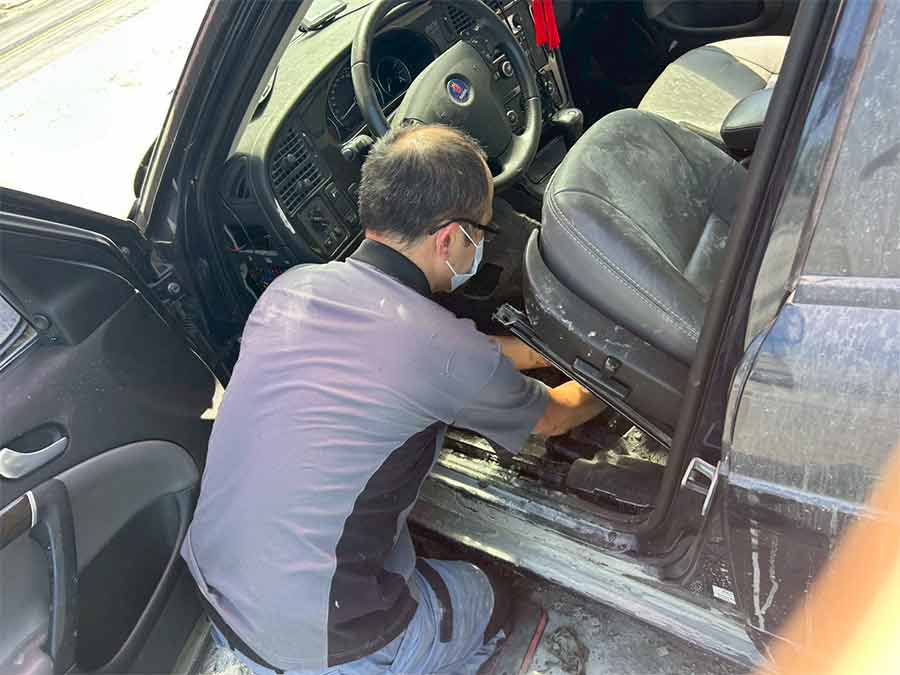
The Journey South: Two Technicians, One Mission
On October 8, at 6:00 a.m., two of our technicians set off from Tucheng, New Taipei City. They carried a simple brief:
Travel across half the island, reach a disaster zone, and bring a Saab back to life.
Transporting the car by tow truck would have cost nearly NT$20,000 (~650 USD), and even then, tow operators were unwilling to enter the mud-locked village. So we brought the workshop to the car.
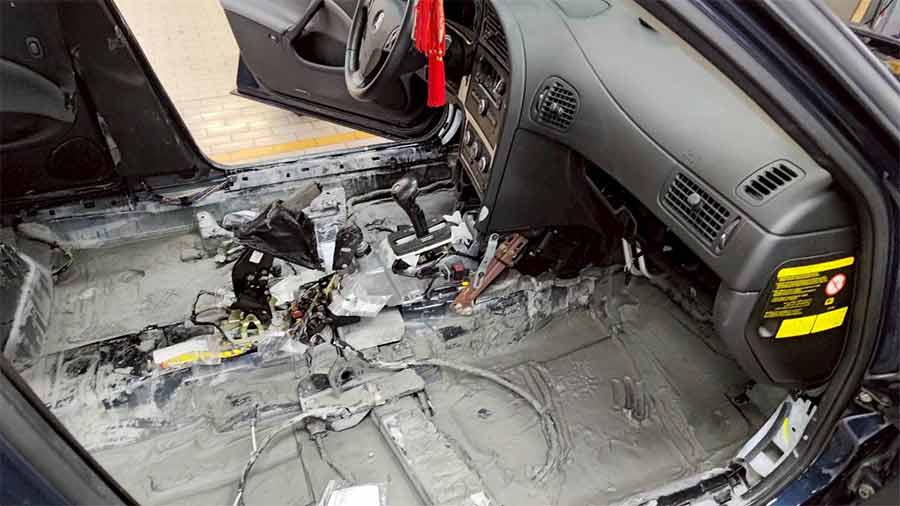
When we arrived, the scene was overwhelming. Homes stood open like broken shells. The ground squished under every step. And in the center of a courtyard sat the Saab 9-5 – its interior soaked, its carpeting glued to the floorpan by dried gray silt, its electronics buried under a thick crust, and every corner smelling of stagnant water.
Yet its silhouette still carried dignity. The badge on the steering wheel still caught the light. The body lines still traced the unmistakable profile of the last classic 9-5 generation.
We rolled up our sleeves.
Reviving a Flooded Engine in a Sea of Mud
The first two hours were the hardest. We had to work with our feet literally sinking into patches of mud, brushing sludge from connectors, draining water from intake pipes, and coaxing the engine to respond.

Floodwater had seeped into the cabin through the doors, climbed over the sill plates, and continued rising until the center console was submerged. Electrical connectors were brittle with dried sediment, and sensors were hidden under layers of clay.
Bit by bit, we scraped, cleaned, dried, and reconnected.

And then – after enough attempts to make even seasoned mechanics nervous – the Saab turned over. The engine shook, coughed, cleared its throat, and finally settled into a steady idle, as if relieved to return from the dead.
That moment, with mud beneath our boots and the sun reflecting off the hood, felt like the first breath of recovery – not just for the car, but for the whole street. Neighbors watched from their doorsteps, some smiling for the first time in weeks.
A Six-Hour Drive to Tucheng: Saab Spirit on the Open Road
Normally, after such a revival, a car would be loaded onto a transporter. But not this time. We chose to drive it.
That six-hour trip north was a quiet reminder of Saab engineering philosophy: cars built not merely to meet specifications, but to withstand real-world adversity. Even with its entire interior stripped and electronics barely reorganized, the 9-5 moved with surprising composure.
Of course, we kept every kilometer gentle. The engine needed circulation, not stress. The transmission needed warmth, not load.
By the time we reached Tucheng, the car had earned more respect than some pristine showroom examples.
Inside the Restoration: Pulling a Saab Back From the Flood
What followed was nearly a month of work – a full, ground-up restoration that required patience and a precise understanding of how the 9-5 was engineered.
Every carpet section, every piece of sound insulation, and every inch of wiring harness had to be removed, washed, dried, disinfected, or replaced. The floorpan alone required days of scraping and steam cleaning to free it from layers of hardened silt.

As the images show, the cabin looked like an archaeological site: cracked mud where the footwells had been, puddles of clay water in the transmission tunnel, and electrical systems hidden under a blanket of sediment.
We rebuilt the Saab systematically:
- All interior components were extracted and processed individually.
- The HVAC ducts were flushed repeatedly.
- Modules were inspected one by one—some saved, some replaced.
- Drain routes were restored and resealed.
- The fuel system was cleared and checked for contamination.
- Every connector received a cleaning process that would satisfy an aircraft technician.
Once the body shell was clean and dry, reassembly began. The moment the dashboard, seats, and carpets returned to their rightful places, the cabin started to feel like a Saab again – not a flood relic.
Doing the Right Thing: Repairs Below Cost
There is no standard procedure for pricing restoration after a natural disaster. But we knew one thing: this family needed support, not invoices.
So SAC Motors offered Mr. Wu a special discount, completing the project – including parts and labor – for under NT$40,000 (1,300USD).
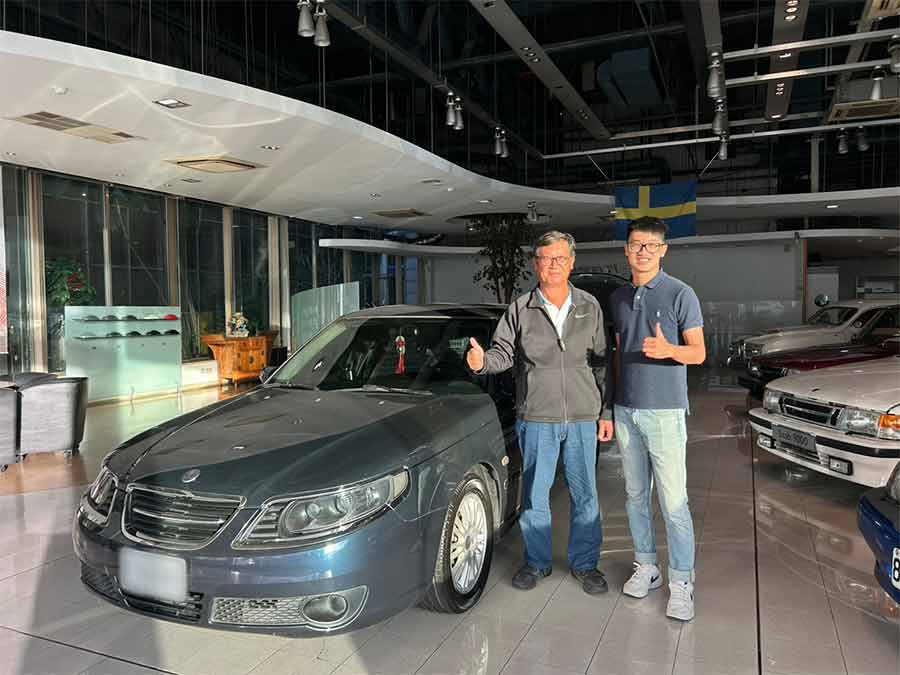
The amount did not reflect market value. It reflected empathy. It reflected respect. It reflected the responsibility we feel toward every Saab that carries a family’s history.
As we later told Mr. Wu: “We only did what any Saab caretaker should do.”
The Return: A Saab Reborn, a Family Made Whole
On November 9, nearly a month after we first stepped into the mud of Guangfu, the Saab rolled back into Hualien – clean, restored, and ready to start its next chapter.
Mr. Wu and his family were waiting for us. Their faces said everything. What they saw was not an old sedan. It was the return of a companion that had shared their lives for nearly twenty years.
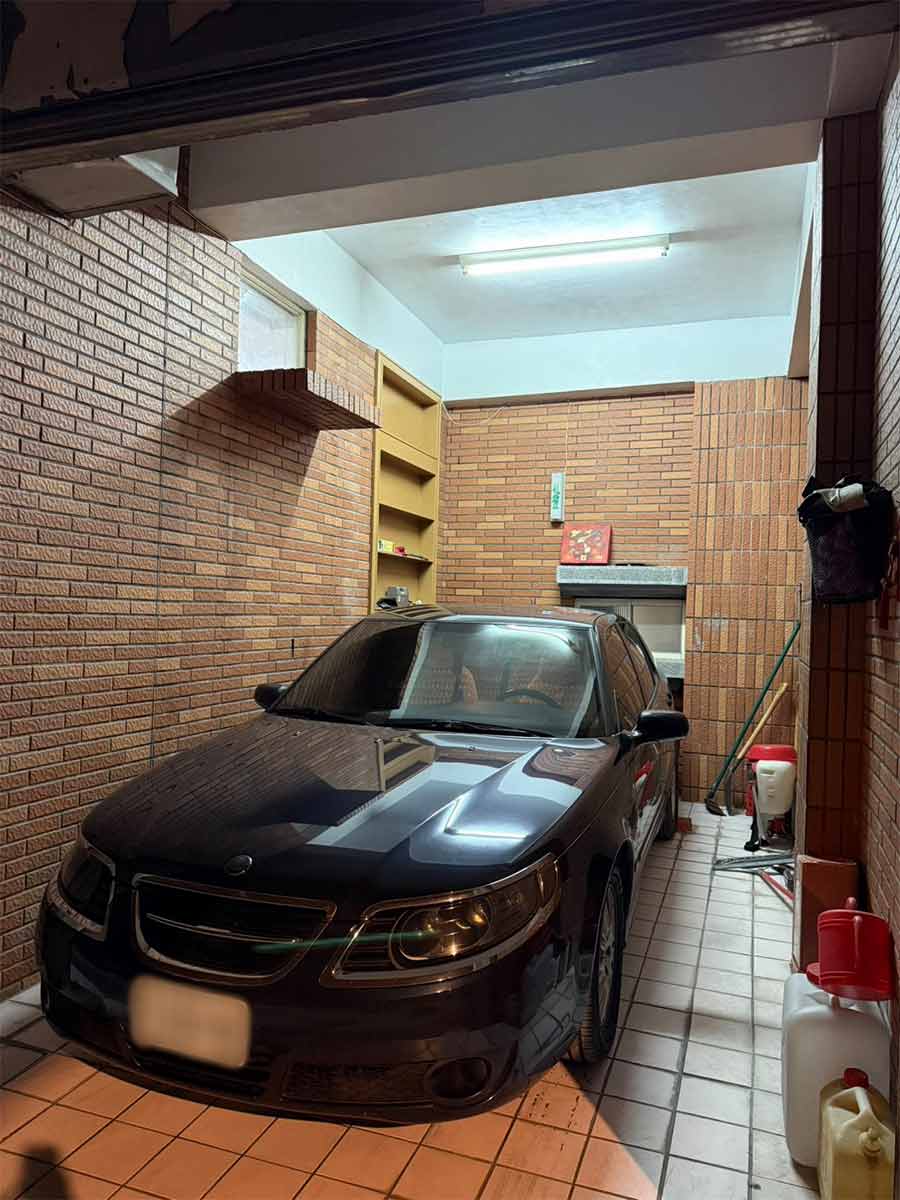
For us at SAC, delivering the car felt almost ceremonial – closer to returning a family heirloom than handing over a repaired vehicle. The Facebook message we posted later could not have expressed it better:
“We know this wasn’t just a car. It was a member of the family.”
And that is why this story matters. Because in a time of destruction, a Saab became a symbol of continuity and hope – a reminder that memories can be rescued, restored, and taken home again.

